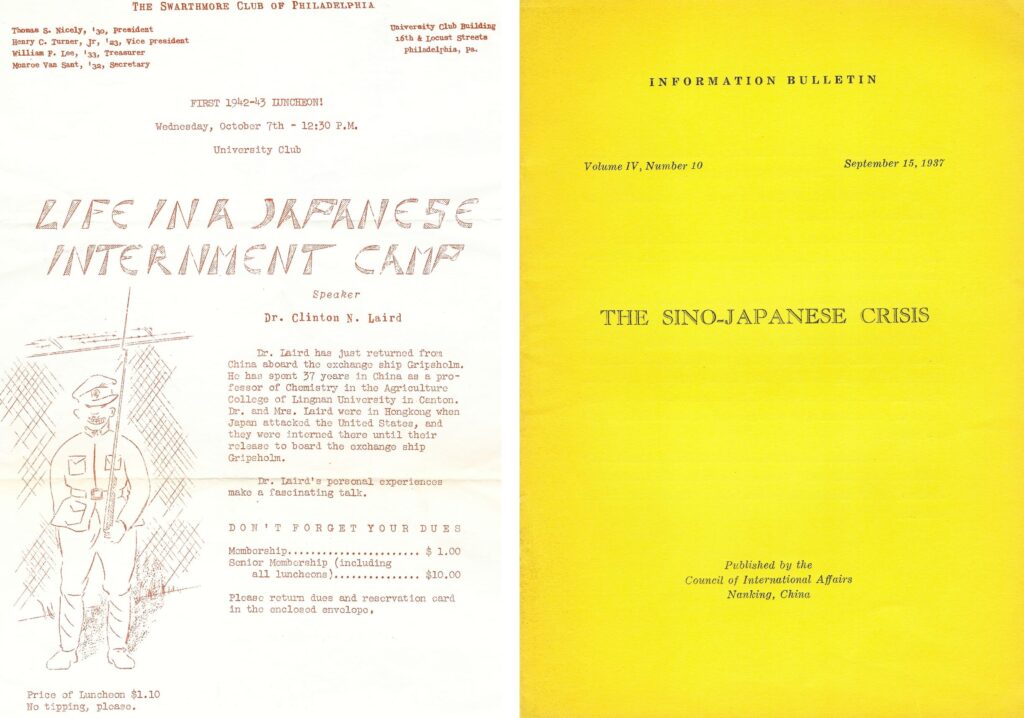Disclaimer: This post contains images of historical documents, some of which include perspectives and language reflecting the time in which they were written. The Claremont Colleges Library does not endorse all the views expressed in these documents.
In the past weeks we have introduced Ch’en Shou-yi’s contributions to the East-West exchange. As for the East civilizations, China is not Ch’en’s only one research topic. Actually, Chen did comprehensive research on other East Asian countries like Korea and Japan. This week I processed booklets, which were collected by Ch’en, and I was impressed by the many booklets on Japan. On the one hand, the booklets published from 1930s to 1940s reflected Japanese military aggression and expansion. On the other hand, the booklets published after WWII reflected the reconstruction and development of Japan and Japanese culture.
When the Second Sino-Japan War (China calls it Anti-Japanese War in these booklets) broke out in 1937, governmental and non-governmental agencies published many booklets to disclose the war crimes of Japanese invaders, report on the suffering of refugees, and appeal to the world for aid. For example, in 1933, The Intelligence and Publicity Department published a bulletin on the Japanese military aggression in Shanghai. In 1937, Chinese scholars Jen Tai (任泰) and Shuhsi Hsü (徐淑希) wrote several Information Bulletin to discuss the Japanese aggressive expansion policy in North China and related Sino-Japanese Crisis. In 1938, the China Information Committee, an official ministry of information of the Chinese Nationalist Party (KMT), published a series of booklets reflecting the Japanese invasion and propaganda in China. In a booklet Pictorial Evidence of Japanese Atrocities, the China Information Committee even attached pictures of executions by the Japanese military. In 1938, The Press Bureau of The Chinese Delegation published booklets criticizing the uselessness of the League of Nations in the Japanese invasion. Non-governmental agencies like Manchuria Refugees’ Relief Association exposed Japanese brutalities in Manchuria in a booklet. In addition, Ch’en collected booklets written and published by non-Chinese. Facts of The China Trouble was published by the contemporary Japanese Chamber of Commerce, trying to find excuses for Japanese aggression. The Sino-Japanese Issue Series contains some issues written by foreign reporters like (Mrs. Paul D.) Mary Fine Twinem, S. Lautenschlager, Rev. E. Stanley Jones, D.D., recording their witness of Japanese aggression in China. Additionally, as we introduced last week, Dr. Clinton N. Laird published his Life In A Japanese Internment Camp in 1943, introducing his family captured by Japanese invaders in Hong Kong. Chinese Americans also organized United China Relief to save Chinese refugees. After visiting China and talking to suffering people, United China Relief published What Li Wen Saw, to appeal to the American people for refugee relief.

After WWII, Ch’en got an opportunity to visit Japan, and collected booklets reflecting Japanese religion and culture, especially on famous Japanese Buddhist temples like 熊野寺 (Kumano Temple) and 西光寺 (Saikou Temple). Japan: A Packet for Teachers contains a series of booklets on Japanese culture and history published by the Japan Society. In 1957, Japanese Prime Minister Kishi visited the US, and Ch’en collected the booklet published by Consulate General of Japan. At that time, the US and Japan had been allies and Japan was recovering rapidly form the war. As a Chinese American scholar, Ch’en paid attention to the suffering people of his homeland. With the end of the war, he finally focused on his interest in culture and history, and even had the opportunity to visit Japan in person. Booklets on Japan in Ch’en’s collections reflected two sides of Japan: the war provoked by aggressive Japanese invaders led Japan to the verge of destruction while peace made Japanese culture prosperous.

